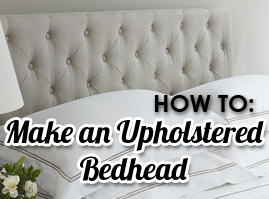How To Make An Upholstered Bedhead
How To Make An Upholstered Bedhead
A striking upholstered bedhead can provide a sophisticated focal point of a bedroom; giving a room a sense of luxury and turning a blank wall into a feature wall without a drop of paint in sight. Unfortunately, that ‘designer look’ can come at a pretty steep price, with upholstered and decorative buttoned bedheads selling in stores from $900 up to $3000 and higher! However, what might surprise you, is that achieving this high-end look is actually very simple and cost effective when you have the right products, some helpful advice and a little bit of DIY spirit.
OTHER THINGS YOU MIGHT NEED
- Upholstery fabric of your choice (Metres required depends on size of bedhead)
- MDF Board (Usually 16mm to 18mm thick) - (Cut to the dimensions/shape of your bed head)
- Electric Bread/Carving Knife - To cut foam sheet (substitute for Stanley knife)
- Screwdriver & Screws
DIMENSIONS OF BEDHEAD
When deciding on the dimensions for your bed head, you should take into consideration the bed size, style, room size/height & even other decor (including pillows, artwork & bedside lamps).
- Dimensions will differ depending on whether the bed head is floor resting or wall-mounted.
- For wall mounted: measure from mattress up to where you would like the top edge of the bedhead to finish on the wall
- For freestanding height: measure from the base of the ensemble up to where you would like the top edge of the bedhead on the wall
Some popular sizes options include:
|
Bed Size |
Width |
Height (Wall Mounted) |
Height (Freestanding/Ensemble-Mounted) |
|
Single |
100cm wide |
80cm high |
130 high |
|
King Single |
115cm wide |
80cm high |
130 high |
|
Double |
145cm wide |
100cm high |
130 high |
|
Queen |
160cm wide |
100cm high |
140 high |
|
King |
190cm wide |
100cm high |
140 high |
BEDHEAD SHAPES
Apart from the popular& ever-classic square/rectangular bedhead shape, there are a range of other shapes you can choose from, for a more decorative style.

Please note, cutting to these shapes would require access to and some experience with a jigsaw.
STEP-BY-STEP INSTRUCTIONS
1. Cutting & Drilling the MDF Board
Mark and cut MDF to size using a jigsaw (or have it cut at your hardware store).
2. Mark and Drill Holes for Buttons
Tip: Lay your MDF board flat on the floor and place a few 20 cent pieces where you imagine your buttons going. This way you can determine the pattern, spacing and quantity of buttons before drilling holes in the MDF
- Measure and mark a grid on MDF, intersecting lines where you want buttons to be positioned. Drill a small hole where lines intersect (this will become the hole you thread your buttons through)
3. Preparing the foam
Tip: The thicker the foam the greater the depth of the bed head as well as the depth of the ‘buttoning effect’. For a more dramatic ‘deep-button effect’ it is recommended you use a 75mm or 100mm thick piece of foam. As this can be quite difficult to cut at home, you can have your choice of foam cut to your custom dimensions using our online foam calculator (Select bedhead from the application dropdown).
- Mark and cut foam to same size as MDF using a stanley knife or electric break knife. If using a 25mm thick sheet, apply a small amount of adhesive to foam and glue these two pieces together; to create one 50mm thick piece of foam.
- Try to get the edges of the foam as straight as possible and flush with the edge of the board. The Dacron will help make these edges more curved and smooth.
- Once you are happy with the positioning and size of your foam, it is time to glue it to the mdf board with a contact adhesive. You don’t have to use a lot of glue, but just an even amount on each surface (foam and mdf) to hold them together to stop them from moving as you attach your fabric and dacron wadding.
4. Adding the fibre wrap aka Dacron (optional)
- On a clean, flat surface Lay down Dacron, then foam and board (with mdf facing up).
- Cut piece of polyester fibre/Dacron to size (ensure the edges of dacron can be folded over board for securing - allowing between 5-10cm on each edge).
- Fold edges of Dacron over board, holding firmly and securing Dacron to the back of the board with staples. Fold in and secure corners of Dacron to mdf with staples.
5. Cutting & Layering materials
Tip: If using a patterned fabric, lay the fabric pattern-side-up over the board to ensure you are happy with the placement of the pattern before cutting.
- Lay upholstery fabric face down on a clean, flat surface, then foam and board with mdf facing up. Cut piece of upholstery fabric to size (usually allowing for an additional 20cm around each edge of the board).
6. Attaching the fabric
- With fabric pulled tight, fix to MDF using a staple gun.
Tip: Place one staple in the centre of each edge, to act as an anchor point. This will keep the fabric square and to avoid shifting while you are making your way along each edge.
- Place a few staples into the centre each edge, stopping to check that your fabric is still tight and centred. Continue stapling from the centre to the outside corners. Stop stapling 5cm from the corner.
- Cut off the excess wadding and fabric to remove lumpy or bulky corners. Create a “butterfly corner” by first tucking the centre under, then folding and tucking the material to each side.
- When the corner looks symmetrical and tight, staple the folds in place. Repeat for all four corners.
7. Threading and inserting the buttons
- Thread a button tufter or long, double-pointed straight needle with strong, durable twine (such as nylon tufting/buttoning twine).
- Working from the back of the board, thread needle through 1 hole in the MDF. Thread through a fabric-covered button at front of bed head, then feed needle back through same hole.
- Pull twine firmly to achieve desired ‘indented’ look at front of bed head. Maintaining pressure, tie twine in knot to secure and staple remaining twine to MDF. Repeat steps for each button-hole).
8. Ensuring a neat finish (Optional)
- Measure and cut a length of spunbonded/dustcover fabric to cover back of bed head. This piece should cover rough edges of Dacron and upholstery fabric. Giving the back of the bedhead a neat finish and preventing excess dust from collecting on the back of the bedhead. Affix dustcover piece to back of bedhead with a staple gun.
9. Add Decorative Strips or Nails
Tip: As well as being a more subtle design, running the stud strip along the edges of the mdf makes keeping strips straight much easier than if they were installed on the front of the board.
- Using individual decorative upholstery nails can be time consuming as well as difficult to space evenly and keep in a straight line. For a much easier alternative, with the same designer finish, use continuous stud strips.
- The size of your bedhead will determine how many metres of stud strip you will require but most will need no more than 5 metres of strips with matching nails.
Tip: Strips only need to be installed on visible edges. Since most of the bottom edge of the bedhead will be hidden behind the mattress and pillows, many people choose not to add decorative strips to the bottom of their bedheads.
- Start laying your first strip from one of the top corners, running the strip along the top edge of the mdf board (keeping the strip as straight as possible). You will find that every 5th nail on the strip is a hole, in this hole place a single decorative nail and drive it into the mdf with a Magnetic Tack Hammer or fabric-covered-hammer. Continue installing studding strip along side edges.
Tip: If you don’t have a proper magnetic tack hammer with nylon tip, you can use an ordinary small faced hammer with a bit of fabric over the face to stop the metal on metal causing scratches/chips on the studs. Another alternative is using a piece of blue tack on the end of the hammer to avoid damage.
10. Mounting
Wall mounting
- Find the studs in the wall where the headboard will be hung. Mark on the back of the headboard in pencil where your connectors should be installed to line up with the studs in the wall. Install the mounting brackets onto the wall. Attach the brackets to the headboard with a screwdriver or drill.
Tip: For smaller bedheads two connectors is the minimum needed. However to ensure the bedhead is more secure, particularly for larger bedheads, a third bracket in the middle of the bedhead is recommended.
Mount directly to bed base
- Using our bed bracket sets, it makes it easy to attach your bedhead to your ensemble base, allowing you to move the bedhead as the bed moves.
11. Brag to family & friends because you are a DIY genius!
We would love to see how your project turned out! Send us an email at [email protected]
For more information on products and prices, visit our online store www.homeupholsterer.com.au or call us on 1300 013 333.
We stock a full range of upholstery and furniture supplies for your DIY projects. Visit us at our Sydney warehouse and showroom or order online for shipping around Australia.

